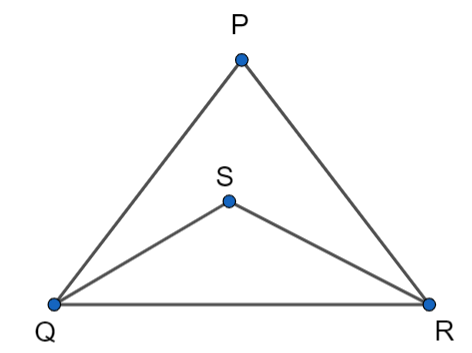
If S is any point in the interior of \[\Delta PQR\]then, prove that \[SQ+SR
Answer
574.8k+ views
Hint: First of all, extend the point S such that the line QS intersects the side PR at point T. Now, join the points Q and S, and points R and S. We know the property that in any triangle the sum of two sides is always greater than the third side. Now, use this property for \[\Delta PQT\] and \[\Delta TSR\] , and get the equations \[PQ+PT > QT\] and \[ST+TR > SR\] . The side QT is the summation of the line segment QS and ST. Now, add both equations. The side PR is the summation of the line segment PT and TR. Now, solve it further and get the required result.
Complete step-by-step answer:
First of all, let us take a point S in the interior of the triangle \[\Delta PQR\] .

Now, extending the point S such that the line QS intersects the side PR at point T.
Similarly, join the points Q and S, and points R and S.
We know the property that in any triangle the sum of two sides is always greater than the third side …………………………………………..(1)
Now, in the \[\Delta PQT\] , we have
\[PQ+PT>QT\] (using the property shown in equation (1))
Now, from the figure of \[\Delta PQR\] , we can see that
\[QT=QS+ST\] ……………………………………(2)
Now, from equation (1) and equation (2), we get
\[PQ+PT>QS+ST\] ……………………………………..(3)
Now, in \[\Delta TSR\] , we have
\[ST+TR>SR\] (using the property shown in equation (1)) …………………………………….(4)
Now, on adding equation (3) and equation (4), we get
\[PQ+PT+ST+TR>SR+QS+ST\]
\[PQ+PT+TR>QS+SR\] ………………………………………………(5)
Now, from the figure of \[\Delta PQR\] , we can see that the side PR is the summation of the line segment PT and TR. So, we can say that
\[PR=PT+TR\] ………………………………….(6)
Now, replacing \[PT+TR\] by \[PR\] in equation (5), we get
\[PQ+PR>QS+SR\] .
Therefore, \[PQ+PR>QS+SR\] .
Hence, proved.
So, the correct answer is “Option A”.
Note: Here, one might think to solve this question without extending the point S to intersect the side PR at point T. If we don’t extend the point our figure will look like

We know the property that in any triangle the sum of two sides is always greater than the third side.
Now, using this property in \[\Delta PQR\] and \[\Delta SQR\] , w have
\[PQ+PR>QR\] ……………………………….(1)
\[QS+SR>QR\] …………………………………(2)
But, the equation (1) and equation (2) is not sufficient to prove \[PQ+PR>QS+SR\] .
So, to get sufficient equations to prove \[PQ+PR>QS+SR\] we need to extend the point S such that the line QS intersects the line PR at T.
Complete step-by-step answer:
First of all, let us take a point S in the interior of the triangle \[\Delta PQR\] .

Now, extending the point S such that the line QS intersects the side PR at point T.
Similarly, join the points Q and S, and points R and S.
We know the property that in any triangle the sum of two sides is always greater than the third side …………………………………………..(1)
Now, in the \[\Delta PQT\] , we have
\[PQ+PT>QT\] (using the property shown in equation (1))
Now, from the figure of \[\Delta PQR\] , we can see that
\[QT=QS+ST\] ……………………………………(2)
Now, from equation (1) and equation (2), we get
\[PQ+PT>QS+ST\] ……………………………………..(3)
Now, in \[\Delta TSR\] , we have
\[ST+TR>SR\] (using the property shown in equation (1)) …………………………………….(4)
Now, on adding equation (3) and equation (4), we get
\[PQ+PT+ST+TR>SR+QS+ST\]
\[PQ+PT+TR>QS+SR\] ………………………………………………(5)
Now, from the figure of \[\Delta PQR\] , we can see that the side PR is the summation of the line segment PT and TR. So, we can say that
\[PR=PT+TR\] ………………………………….(6)
Now, replacing \[PT+TR\] by \[PR\] in equation (5), we get
\[PQ+PR>QS+SR\] .
Therefore, \[PQ+PR>QS+SR\] .
Hence, proved.
So, the correct answer is “Option A”.
Note: Here, one might think to solve this question without extending the point S to intersect the side PR at point T. If we don’t extend the point our figure will look like

We know the property that in any triangle the sum of two sides is always greater than the third side.
Now, using this property in \[\Delta PQR\] and \[\Delta SQR\] , w have
\[PQ+PR>QR\] ……………………………….(1)
\[QS+SR>QR\] …………………………………(2)
But, the equation (1) and equation (2) is not sufficient to prove \[PQ+PR>QS+SR\] .
So, to get sufficient equations to prove \[PQ+PR>QS+SR\] we need to extend the point S such that the line QS intersects the line PR at T.
Recently Updated Pages
Two men on either side of the cliff 90m height observe class 10 maths CBSE

What happens to glucose which enters nephron along class 10 biology CBSE

Cutting of the Chinese melon means A The business and class 10 social science CBSE

Write a dialogue with at least ten utterances between class 10 english CBSE

Show an aquatic food chain using the following organisms class 10 biology CBSE

A circle is inscribed in an equilateral triangle and class 10 maths CBSE

Trending doubts
Why is there a time difference of about 5 hours between class 10 social science CBSE

Write a letter to the principal requesting him to grant class 10 english CBSE

What is the median of the first 10 natural numbers class 10 maths CBSE

The Equation xxx + 2 is Satisfied when x is Equal to Class 10 Maths

Which of the following does not have a fundamental class 10 physics CBSE

State and prove converse of BPT Basic Proportionality class 10 maths CBSE




